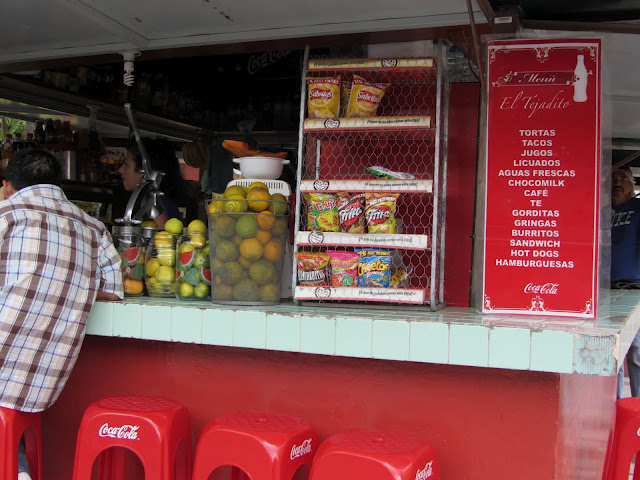We eat a lot of Mexican food in California. Whether just a snack of tortilla chips and salsa or our Christmas Eve meal of tamales this cuisine is an important part of our lives. 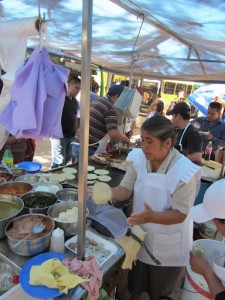 It was hard living without it. We tried Mexican food in Rishikesh, India. Twenty-four hours later we all got violently ill. We went to a Mexican restaurant in Buenos Aires. Overpriced and mediocre with incredibly weird beans. We ate tacos in Chiang Mai, Thailand. A Canadian owned the restaurant. It was the best of the year. Until we got to Mexico.
It was hard living without it. We tried Mexican food in Rishikesh, India. Twenty-four hours later we all got violently ill. We went to a Mexican restaurant in Buenos Aires. Overpriced and mediocre with incredibly weird beans. We ate tacos in Chiang Mai, Thailand. A Canadian owned the restaurant. It was the best of the year. Until we got to Mexico.
Some of the best eating in Mexico was on the streets. We had been so careful in other countries with street food, and despite being careful we had been sick in almost every country. But there was no way we were going to miss out of the flavors of Mexico. And the flavors live in the street. At taco stands or puestas, at fruit stalls and chip stands, at stands selling fruit drinks or agua frescas, at ice cream carts and pots full of tamales. We found our joy so easily. Of course, we each got sick in Mexico. We never knew which food had made us sick. It was usually too hard to figure out. And it didn’t matter. We just wanted to taste the essence of Mexico. And we found it on the street.
The most important flavor in Mexico is corn. The ancient Mexicans figured out how to process it.  Once the corn is ground it’s mixed with water and sometimes lard to make a dough or masa. There are so many shapes into which masa is formed. These shapes then hold all sorts of good tasting foods. In Mexico City, in the Zocalo, the original plaza of the Aztecs, we tried a tlayuda. It started with a large thin crisp of blue corn, rendering a crisp yet slightly chewy base. It was then smeared with refried beans and sprinkled with roasted cactus leaves, hot sauce, and cheese. In Guanajuato we discovered the chalupa or “canoe”. The yellow corn masa is formed into the shape of a small boat and then deep fried. It is the crispy, slightly greasy vehicle for beans, cabbage, cheese, and, of course, the red or green salsa of your choice. The mix of textures were perfect: the chalupa was so crisp it would crackle as I bit it, the beans were a soft interlude, and the cabbage provided a crunch. The salsa invariably ran down my arm as the chalupa fell apart on the first bite.
Once the corn is ground it’s mixed with water and sometimes lard to make a dough or masa. There are so many shapes into which masa is formed. These shapes then hold all sorts of good tasting foods. In Mexico City, in the Zocalo, the original plaza of the Aztecs, we tried a tlayuda. It started with a large thin crisp of blue corn, rendering a crisp yet slightly chewy base. It was then smeared with refried beans and sprinkled with roasted cactus leaves, hot sauce, and cheese. In Guanajuato we discovered the chalupa or “canoe”. The yellow corn masa is formed into the shape of a small boat and then deep fried. It is the crispy, slightly greasy vehicle for beans, cabbage, cheese, and, of course, the red or green salsa of your choice. The mix of textures were perfect: the chalupa was so crisp it would crackle as I bit it, the beans were a soft interlude, and the cabbage provided a crunch. The salsa invariably ran down my arm as the chalupa fell apart on the first bite.
 In Guanajuato we headed to El Jardín de Embajadoras, a plaza known for its tlacoyos. The masa is shaped into a pointed oval as it’s folded around a filling of meat or beans or cheese. Then the package is cooked on the skillet or comal. Of course, there is a variety of spicy salsas waiting on the counter to pour over the tlacoyo and to enhance the combination of bean and corn. We would often choose a salsa verde as it seemed to compliment the pork we kept ordering.
In Guanajuato we headed to El Jardín de Embajadoras, a plaza known for its tlacoyos. The masa is shaped into a pointed oval as it’s folded around a filling of meat or beans or cheese. Then the package is cooked on the skillet or comal. Of course, there is a variety of spicy salsas waiting on the counter to pour over the tlacoyo and to enhance the combination of bean and corn. We would often choose a salsa verde as it seemed to compliment the pork we kept ordering.
In the Plaza Baratillo there were a score of puestas selling food over the course of the day. During the day most sold tacos and/or gorditos.  Often the tortilla was handmade, a ball of soft masa is pressed flat in a tortilla press then thrown on the comal to cook. There are a dozen or so tins of guisados or stews. My favorite always involved pork often in a red chili sauce. I never tried the tripe. Cat, our vegetarian, would break with her strict diet accepting the lard that enriched the beans. In contrast to the tacos gorditas were made by not pressing the ball of masa quite so thin. The dough would puff like pita bread. The women running the puesta would slice open the pocket and fill it with the guisado of our choice. The gordita had a heftier masa bite than the tortilla. I preferred the gordita, Bill and Hank the tacos.
Often the tortilla was handmade, a ball of soft masa is pressed flat in a tortilla press then thrown on the comal to cook. There are a dozen or so tins of guisados or stews. My favorite always involved pork often in a red chili sauce. I never tried the tripe. Cat, our vegetarian, would break with her strict diet accepting the lard that enriched the beans. In contrast to the tacos gorditas were made by not pressing the ball of masa quite so thin. The dough would puff like pita bread. The women running the puesta would slice open the pocket and fill it with the guisado of our choice. The gordita had a heftier masa bite than the tortilla. I preferred the gordita, Bill and Hank the tacos.
Our favorite stand of Plaza Baratillo was one that didn’t start its operation until after 6pm. They didn’t serve beans. Only tacos with meat. During our last week in Guanajuato (and of our year) Cat got the flu. 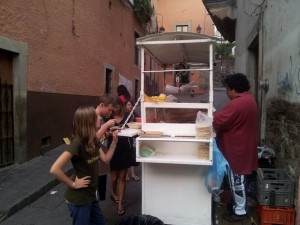 Bill, Hank, and I left her at home and headed to the stand for dinner, three nights in a row. The men who ran the stand didn’t make their own tortillas. They made their tacos with two tiny tortillas like the ones at taco trucks in Oakland. They had chopped the meat before grilling it on the skillet. As the meat cooked lard was rendered into a groove around the comal. They dipped the tortillas in the lard before heating them. Then filled the tortillas with meat of our choice (carnitas, chorizo, chicken, or al pastor) and added grilled onions, cilantro, and fresh onions. We chose from the salsa bar either salsa roja, salsa verde, or avocado salsa. If I forced it I could eat three tacos. Hank, one evening, ate seven.
Bill, Hank, and I left her at home and headed to the stand for dinner, three nights in a row. The men who ran the stand didn’t make their own tortillas. They made their tacos with two tiny tortillas like the ones at taco trucks in Oakland. They had chopped the meat before grilling it on the skillet. As the meat cooked lard was rendered into a groove around the comal. They dipped the tortillas in the lard before heating them. Then filled the tortillas with meat of our choice (carnitas, chorizo, chicken, or al pastor) and added grilled onions, cilantro, and fresh onions. We chose from the salsa bar either salsa roja, salsa verde, or avocado salsa. If I forced it I could eat three tacos. Hank, one evening, ate seven.
In the Mercado Hildago the vendors sell food. There stalls selling fresh fruits like strawberries, mangos, and rambutan, vegetables like cactus leaves and chayote, milk, cheese, and meat. And then there are the restaurant stalls. We walked past the tostados with seafood, I drooling, the rest of my family not at all interested. Then we found the carnitas stand. Cat still was not interested, but the rest of us paused. The vendors stood with large chunks of pork in their hands, ready to hand out their samples. I took one and bit in. The intensity of the flavor and the tenderness of the bite was wonderful. We watched Hank as he ordered a taco, doused it with salsa and headed toward gustatory bliss. Bill and I had just eaten lunch and could only dream of how wonderful the taco would be if we were hungry.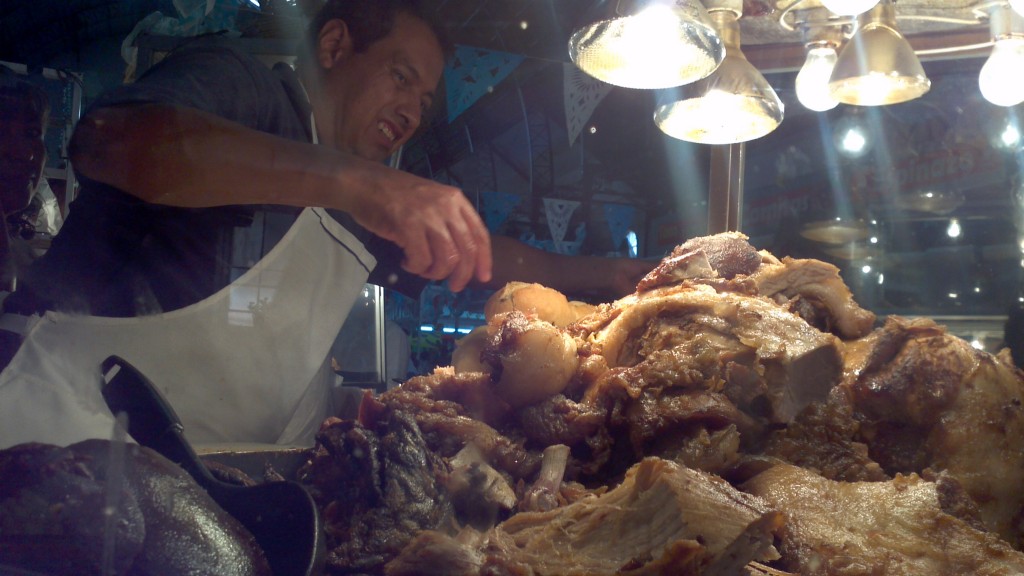
Guanajuato wasn’t hot while we were there, but we had a lot walking to do there. Much of the city was closed to cars; the automobile traffic was in tunnels made from old riverbeds. 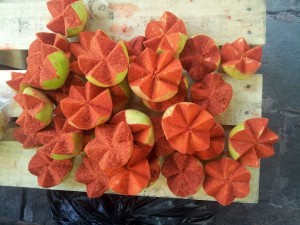 Many of the roads were really just footpaths heading up the ridges to get to another part of town. We were often thirsty. We drank agua fresca. We decided to trust the ice. The family’s favorite flavor was orchata, a cold drink of rice, cinnamon, and sugar. We tried the strawberry, but it often tasted artificial. The watermelon was real and devine. Cut fruit was also available, the classic way to eat it is with a shake of salt, a sprinkle of chili, and a squeeze of lime. We usually ate the mango, but also liked cucumber and jicama (not a fruit). We didn’t try the pears sold on the street, jagged cut and covered in chili.
Many of the roads were really just footpaths heading up the ridges to get to another part of town. We were often thirsty. We drank agua fresca. We decided to trust the ice. The family’s favorite flavor was orchata, a cold drink of rice, cinnamon, and sugar. We tried the strawberry, but it often tasted artificial. The watermelon was real and devine. Cut fruit was also available, the classic way to eat it is with a shake of salt, a sprinkle of chili, and a squeeze of lime. We usually ate the mango, but also liked cucumber and jicama (not a fruit). We didn’t try the pears sold on the street, jagged cut and covered in chili.
Along with the aguas frescas we quenched our thirst with paletas or popsicles. As we headed to the vendor I was sure I was going to make a big leap in adventure. There were so many flavors: lime, coconut, strawberry, strawberry with cream, pistachio, mango, mango with chili. But I always chose tamarindo. It always had the right sweet-sour balance to make my mouth pucker as it melted and left my tongue with a sweet after taste. My kids were more adventuresome. They are still working on which is their favorites.
Ice cream was also a cold treat we favored on the streets. We were told Dolores Hidalgo was a small city most famous for its ice cream. The ice cream was made in tubs and sold from the tubs. Push carts filled with ice and tubs of ice cream fended for a spot at street corners, as many as five on one corner. The flavors were numerous. There were the classic flavors: strawberry, vanilla, chocolate. There were the slightly more daring flavors: mango, caramel, and coconut. And then there are those we had never seen before: tequila, cheese, avocado, and corn. I never found it, but apparently some vendors were pushing octopus ice cream through the streets.
 We weren’t able to sample many of the snacks on the streets. We were never hungry enough to try everything we saw. I did try the roasted corn on the cob slathered in lime-flavored mayo, cheese, and chili sauce. I took three bites and threw it away. It was rich, chewy, and just plain awful. I wanted to try the potato chips with chili sauce poured over them or the Doritos, the bag slit open down the side, with chili and chewy chicharrones poured inside. There were fruits blended whole and poured into cups. Pastries in huge baskets tended by old women tempted me, but I had already indulged in the tacos before I could get to the others. The choices on the streets of Mexico were endless, and we couldn’t sample them all. I guess we’ll have to go back.
We weren’t able to sample many of the snacks on the streets. We were never hungry enough to try everything we saw. I did try the roasted corn on the cob slathered in lime-flavored mayo, cheese, and chili sauce. I took three bites and threw it away. It was rich, chewy, and just plain awful. I wanted to try the potato chips with chili sauce poured over them or the Doritos, the bag slit open down the side, with chili and chewy chicharrones poured inside. There were fruits blended whole and poured into cups. Pastries in huge baskets tended by old women tempted me, but I had already indulged in the tacos before I could get to the others. The choices on the streets of Mexico were endless, and we couldn’t sample them all. I guess we’ll have to go back.